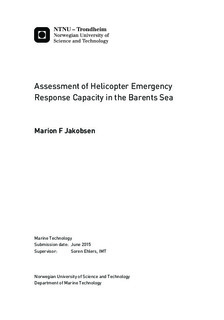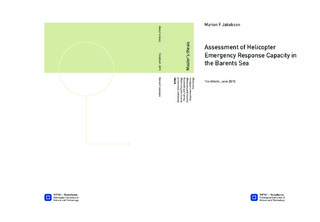| dc.description.abstract | As the global demand for energy is increasing, oil and gas exploration is moving further north to more remote areas. Offshore activity in these areas is challenging. Arctic-specific environmental conditions, and long distances from existing infrastructure are some of the challenges faced. Therefore, new and more robust solutions on technological and operational side are required before commencing operations in the area.
The challenges that search and rescue operations encounter in the High North includes huge distances and areas to cover, time critical operations, and harsh environmental conditions. The vast distances and lack of infrastructure are challenges for evacuation and rescue operations. In this thesis, the helicopter emergency response capacity of operations in the Barents Sea is studied.
The purpose of this thesis is to develop a simulation model framework for mapping the rescue capacity in the Barents Sea. The intention is to assess the probability of a successful rescue at different locations and with given time requirements. The aim of the simulation model is to assess how the wind speed and direction affect the search and rescue helicopter operations in the Barents Sea.
Firstly, a single potential oil field is studied. Secondly, a larger area of the Barents Sea is considered. For the larger area the model establishes the probability of successfully rescuing 1, 5, 15, and 21 people from the sea within the performance requirement of 120 minutes at different locations. This information can be used to evaluate the required level of emergency preparedness at the field of interest.
The evaluated single field is located approximately 200 nautical miles from Hammerfest. A report on this subject was written by the author of this thesis in the fall of 2014. Previous calculations based on deterministically assumed conditions have proved that it was possible to rescue six persons from the sea, at this location (Jakobsen, 2014). The results from the simulation identify that, depending on the wind conditions it is possible to rescue between zero and eleven persons within 120 minutes. However, no consistency in the wind directions is found.
The results from the larger area of the Barents Sea identify little variation in the results in the months evaluated. The effect of the weather is considered to be similar in both summer and winter months. The results show that the distance is the main contribution to the results and that the weather along the route induces some variance in the number of rescued persons. Compared to the result from the single field, there is less variation in the number of people rescued. The variation could be because wind conditions are kept constant along the route for the single field, compared to the larger area where the wind conditions vary along the route.
Based on these results it is suggested that before helicopter transportation, thorough weather observations should be made. The number of passengers should be based on the number found possible to rescue at the given location in the given wind conditions. | |

